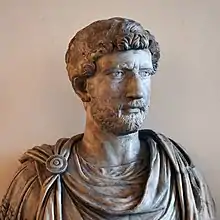The Panhellenion (Greek: Πανελλήνιον) or Panhellenium was a league of Greek city-states established in the year 131–132 AD by the Roman Emperor Hadrian while he was touring the Roman provinces of Greece.

Hadrian was philhellene and idealized the Classical past of Greece. The Panhellenion was part of this philhellenism, and was set up, with Athens at the centre, to try to recreate the apparent "unified Greece" of the 5th century BC, when the Greeks took on the Persian enemy.
The Panhellenion was primarily a religious organization, and most of the deeds of the institution which we have relate to its own self-governing. Admission to the Panhellenion was subject to scrutiny of a city's Hellenic descent.
In 137 AD, the Panhellenic Games were held at Athens as part of the ideal of Panhellenism and harking back to the Panathenaic Festival of the fifth century.
From inscriptions found, member cities included Athens, Megara, Sparta, Chalcis, Argos, Acraephiae, Epidaurus, Amphicleia, Methana, Corinth, Hypata, Demetrias, Thessalonica, Magnesia on the Maeander, Eumeneia, as well the cities of Crete.[1][2]
The name was revived by the first governor of modern Greece, Ioannis Kapodistrias, for a short-lived advisory body in 1828.
References
Other sources
- Benjamin, Anna S. (1963). "The Altars of Hadrian in Athens and Hadrian's Panhellenic Program". Hesperia: The Journal of the American School of Classical Studies at Athens. 32 (1): 57–86. doi:10.2307/147351. ISSN 0018-098X. JSTOR 147351.
- Spawforth, A. J.; Walker, Susan (1985). "The World of the Panhellenion. I. Athens and Eleusis". The Journal of Roman Studies. 75: 78–104. doi:10.2307/300654. ISSN 0075-4358. JSTOR 300654. S2CID 154814654.
- Spawforth, A. J.; Walker, Susan (1986). "The World of the Panhellenion: II. Three Dorian Cities". The Journal of Roman Studies. 76: 88–105. doi:10.2307/300367. ISSN 0075-4358. JSTOR 300367. S2CID 162844591.
- Wörrle, Michael (1992). "Neue Inschriftenfunde aus Aizanoi I". Chiron (in German). 22: 337–376. doi:10.34780/1a9w-zn4e. ISSN 2510-5396.
- Spawforth, A. J. S. (1999). "The Panhellenion Again". Chiron. 29: 339–352. doi:10.34780/c661-9c62.
- Romeo, Ilaria (2002). "The Panhellenion and Ethnic Identity in Hadrianic Greece". Classical Philology. 97 (1): 21–40. doi:10.1086/449565. ISSN 0009-837X. JSTOR 1215544. S2CID 161974097.
- Boardman, John; N.G.L. Hammond; D.M. Lewis; F. W. Walbank; A.E. Astin; J.A. Crook; Andrew Lintott; Elizabeth Rawson; Alan K. Bowman; Edward Champlin; Averil Cameron; Peter Garnsey (2005). The Cambridge Ancient History. Cambridge University Press. ISBN 0-521-26335-2.
- Riccardi, Lee Ann (2007). "The Bust-Crown, the Panhellenion, and Eleusis: A New Portrait from the Athenian Agora". Hesperia: The Journal of the American School of Classical Studies at Athens. 76 (2): 365–390. doi:10.2972/hesp.76.2.365. ISSN 0018-098X. JSTOR 25068025. S2CID 191590607.
- Nasrallah, Laura (2008). "The Acts of the Apostles, Greek Cities, and Hadrian's Panhellenion". Journal of Biblical Literature. 127 (3): 533–566. doi:10.2307/25610139. ISSN 0021-9231. JSTOR 25610139.